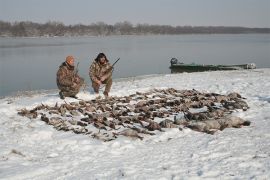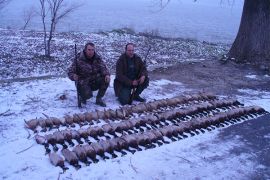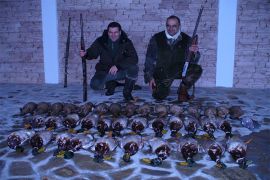Waterfowl hunting trips in Bulgaria - Hunting area Планиново 6560
Goose hunting in Bulgaria - Hunting area Планиново 6560
- Wildfowling - Goose hunting in Bulgaria
Wild duck hunting in Bulgaria - Hunting area Планиново 6560
- Wildfowling - Wild duck hunting in Bulgaria
Find our discounted waterfowl hunting trips in Bulgaria
- Waterfowl hunting trips in Bulgaria directly from outfitters
» Bulgaria Hunting Trips » Waterfowl hunting in Bulgaria » Hunting area Планиново 6560
- Hunting trips directly from outfitters:
Waterfowl hunting trips in Bulgaria
Hunting area Планиново 6560
Book Your Waterfowl Hunts in Bulgaria
Waterfowl hunting trips in Bulgaria
Waterfowl hunting in Bulgaria
- ✓ Waterfowl hunting in Bulgaria
- Планиново 6560
Waterfowl hunting in Bulgaria
Wild ducks hunting trips in Bulgaria
Wild duck hunting is one of the coldest and most exciting types of wing shooting in Bulgaria. There are three types of duck hunting. The first kind is at flight, early in the morning and at dusk. The second kind is with fake lures at the resting spots (reservoirs, dams, rivers and runoff water). The third kind is walked up hunting along river banks, canals and streams.
When hunting in the early hours of the morning, the hunters have to be at the hunting spots before dawn. The birds move from ther feeding spots towards the resting spots. Those are normally large dams and high-water rivers. Wearing warm clothes is recommended, but using camouflage coverings is a must, due to the fact that these birds have a sharp eyesight and a very acute sense of hearing. It is a good idea for hunters to use auditory decoys, so as to direct the birds towards themselves. You may use retriever dogs (Golden Retrievers, Labradors, Drahthaarts, Kurzhaarts and Setters). The dogs need to be very disciplined, compliant and to obey the command Stay in place!. Dogs with experience trace the shot birds by themselves and swiftly retrieve them for their guide.
During the hunts at dusk, it is advisable to lie in wait for the ducks at their feeding spots.
Those are: surface runoff areas (overland flow), harvested fields (rice fields), shallow streams, flooded corn fields (grooves filled with water). It is mandatory to use auditory decoys, so as to direct the birds towards the desired places. It is advisable to use retriever dogs, due to the fact that the hunt takes place in the darker hours of the day. For this kind of wing shooting in Bulgaria, using Drahthaars and Kurzhaars brings greater success. They are able to find the shot birds visually as well as by smell, while Labradors and Golden Retrievers tend to track the bird visually and are more suited for hunting at wide open water areas (reflective water surfaces).
Walked up hunting is the second method of hunting ducks. That is an emotion-filled outing involving long hikes, which is why the hunter must be in excellent health. This kind of hunt is most sucessful when the bigger dams in the area freeze over. Smaller canals and rivers do not allow the water to freeze even at temperatures below - 15 degrees. Birds are aware of that and they find favourable conditions to rest and eat. It is recommended to start this type of hunt at 6 am, and it can last until as late as 5 pm. It may then be combined with an evening hunt at dusk. Combined, the two types of hunt can bring wonderful results. During walked up hunts, it is good to use a guide who knows the places where the birds rest during the day. Once you near the resting spots, you need to move quietly and stay low. You need to use the surrounding vegetation as a cover while you approach the birds and use the element of surprise. It’s possible to lift between 20 and 50 birds into the air at one of these spots. When moving along a riverbank or canal, you need a disciplined dog that walks no more than 15 - 20 steps ahead of you. Once you near the resting spots, the dog must obey the command Heel! or Behind me! so as not to lift the resting game birds. In Bulgaria, the most widely established dog breeds are Drahthaar and Kurzhaar. Once the birds have been shot, the dogs must retrieve the birds from water as well as dry land under the command Retrieve!. The dog must be able to maneuvre through obstacles (water obstacles, fallen trees, ponds, etc.) - in other words, it needs to be hardy while retrieving.
The third kind of hunting is by lying in wait for the birds at their resting spots. Those are: large reservoirs (dams), surface runoffs. It is mandatory to use lures (decoys). It is advisable to put between 40 and 100 duck decoys into the water. It is good to have two or three pairs of spinning wing decoys (mojos). You may use mobile duck decoys with electric motors, so as to create the illusion that the birds are moving. The hunters need to have made a temporary hiding place at the river bank. It must blend in with the terrain so as not to arouse suspicion in the birds. A boat camouflaged with reed vegetation can be used for the same purpose. Hunting by boat allows the hunters to choose the hunting spots for themselves. When using decoys in such cases, they need to be mobile, with built-in chords and weights (so that they can be thrown directly from the boat).
Mallard Identification
Male has green head with olive green bill. Wings of both sexes have purplish / blue speculum and white underside. Concentrations of mallards are typically found near agricultural grain fields that are situated near wetlands or river courses. This species nest throughout country and especially in The Danube plain. Mallards typically return to feeding areas so scout your hunting area to locate where the birds are feeding. A mallard call can be quite successful in luring this bird to decoy spreads.
Geese hunting trips in Bulgaria
Goose hunting involves early mornings and very cold treks. This type of wing shooting in Bulgaria is effective while the birds are in flight in the morning and late afternoon.
In the morning the geese are stalked by the places they have rested at (big lakes and rivers). Places that offer a vantage point are chosen, allowing the hunters pick the birds off before they manage to climb beyond the hunters’ range. The best distance for shooting geese is about 30 to 40 m. This is a very resilient bird and that is why bigger pellets must be used (№ 1, № 0, № 2/0 and № 4/0).
In the late afternoon the geese can be stalked by the places they rest at overnight (big lakes and rivers), usually by the edge of the water. The use of goose calls is recommended in order to lure the birds in the desired direction. At dusk the shooting distance can range from 15 to 30 m.
The second way to hunt geese is at their feeding spots.These are fields with wheat crops still in the early stages of their growth, the main food source for the geese. After the field is chosen a hideout that blends in with its surroundings is constructed. The hideout can be set up some time before the hunt allowing the birds some time to get accustomed to its presence.
Decoys with and without spinning wings can be used as well as 3 artificial magpies and 50 to 100 static birds, mimicking a flock of feeding and resting geese. Other types of decoy birds can be used in order to create the illusion of a peaceful field. Shooting distance ranges between 15 to 30 m.
Hunters can use goose calls to direct the flocks to the desired spots and because the birds drop down from great heights the hunters must have patience and wait for them to come within range. Shooting is under the command of the guide (Now! etc.). These are powerful birds with good plumage. If shot at prematurely there is a chance to miss or wound the goose.
A retriever dog can be used. It must be well-disciplined and obey the command Stay! and must be kept inside the hideout. Geese hunts can last the entire day and the hunt itself is static and in cold weather.That is why heat insulating clothes, warm winter boots and neoprene socks are a must for this type of wing shooting in Bulgaria.
When to hunt Goose Geese?
Goose hunting season in the Bulgaria starts in Oktombre. It gains tempo when the geese begin their migration from Russia to warmer places.
- BOOK YOUR HUNT IN BULGARIA
Къде може да ловувате къто гост-ловец
Препоръчано от ловци за ловци!
Ловните дружини са обединения на физически лица - български граждани, придобили право на лов по предвидения в закона ред. Формирането на дружините е израз на свободно упражненото от учредителите право на сдружаване, признато и гарантирано от Конституцията на Република България.
BG Hunters (bghunters.com) Ви пожелава незабравим и успешен лов!
Наслука
Контрол по време на лов
Отговорникът с контролна власт е министърът на земеделието и храните в съдействие с Изпълнителната агенция по горите. Ако искам да ловувам по правилата, ще трябва да внимавам със следното:
- За всяко провеждане на лов се издава писмено разрешително.
- Отстреляният дивеч, дивечовите кожи и ловните трофеи принадлежат на ловеца само когато той ги е придобил, при спазване на условията, определени от стопанистващия дивеча.
- Ловците нямат право да препарират, притежават, излагат на публични места, пренасят, превозват или да изнасят зад граница дивеч или дивечови продукти без съответния документ за произход.
- Не се разрешава участието в лова на ловец, ако е употребил алкохол или наркотични вещества!
- Важно! Не си правя експерименти с наредбите и ограниченията спрямо разрешения лов по календарни дни! За щетите, нанесени върху дивеча, забранен за лов в тази част на годината или изобщо, се заплаща глоба!
Какво е индивидуално ловуване?
Председателят на дружината издава на ловеца разрешително за индивидуален лов на мигриращ дивеч за срок не по-дълъг от един календарен месец. Ловецът, преди започване на лова вписва датата на ловуване и непосредствено след завършване на лова вписва в разрешителното вида и количеството на отстреляния дивеч и и носи разрешителното при всяко излизане на лов в ловностопанския район.
Най-късно 3 дни след отбелязаната в разрешителното последна дата за ловуване, ловецът връща на председателя на дружината попълненото с всички данни /вид и брой отстрелян дивеч/ разрешително;
Разрешителните за индивидуален лов на мигриращ дивеч за месеца се предоставят от специалиста по ловно стопанство към сдружението на председателя на дружината в два екземпляра
При индивидуалното ловуване на хищници срокът за ловуване е до един календарен месец и се заплаща само таксата за издаване на разрешителното от 1 лв.
Придобитият при ловуването трофей се обработва и регистрира в едномесечен срок в ДГС или ДЛС, в чийто район на дейност е ловностопанския район, в който е отстрелян дивеча с трофей. След или преди регистрацията се извършва оценка на трофея от оценителна комисия към съответното ДГС или ДЛС.
Какво е групово ловуване?
В разрешителното за лов се вписват имената на ловеца или ловците/при групов лов/, номерата на ловните билети и членските карти, датата/при групов лов/ или датите/при индивидуален лов/ на ловуване, мястото/ловището или местността/ на ловуване, вида и броя на разрешения за острел дивеч и името на ръководителя на лова при групов лов.
Разрешителните за групово ловуване на мигриращ и водоплаващ дивеч се издават от специалиста по лова по предварителна заявка от председателя на дружината и съдържаща броя на разрешителните, вида дивеч, който ще се ловува, ловищата, в които ще се ловува и датите на ловуване. Попълнените с тези данни първи екземпляри на разрешителните се предоставят на председателя на дружината, който вписва имената на ръководителя на лова и му предоставя попълнения първи екземпляр на разрешителното, заедно с талоните към него.
- Ръководителят на лова преди започване на лова вписва в разрешителното имената на ловците, серийните номера на техните ловни билети и членски книжки, провежда инструктажа по чл.59, ал.3, т.4, събира сумите по чл. 65, ал. 2 и им раздава талоните. Непосредствено след завършване на лова ръководителят на лова попълва в разрешителното резултатите от ловуването/вид и брой на отстреляните птици/ и талоните на участниците в лова.
- В 3-дневен срок ръководителят на лова връща попълненото разрешително заедно с неизползваните талони и събраните суми на председателя на дружината.
- Ненавременното отчитане на разрешителни за лов и превеждане на дължимите средства за тях могат да бъдат основание за отказ от предоставяне на нови разрешителни от страна на ДГС /ДЛС/.
Мерки за безопастност:
- всеки ловец трябва да бъде инструктиран и да спазва мерките за безопастност при боравене с оръжие и по време на лов;
- всеки ловец трябва да бъде екипиран с ленти, шапка или облекло с ярък сигнален цвят;
- забранява се употребата на алкохол и наркотични /упойващи/ средства преди и по време на ловуването.



